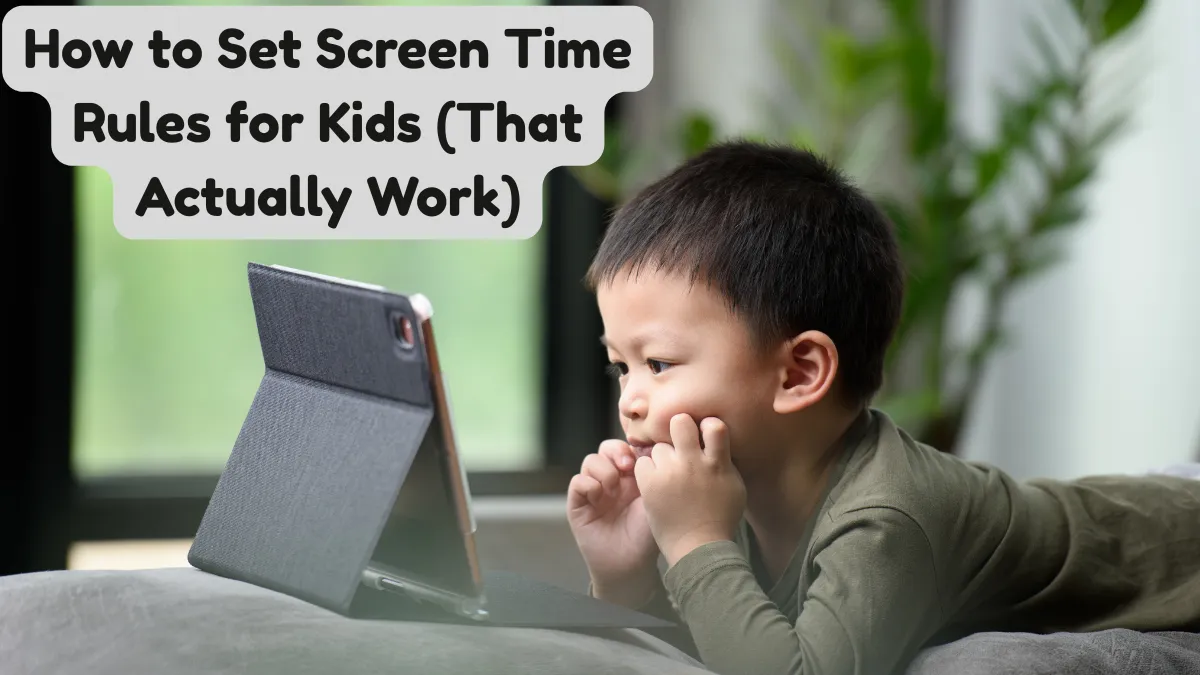Introduction: Understanding Screen Time by Age in 2025
In 2025, screens are everywhere—TVs, tablets, smartphones, computers, smartwatches, and even educational toys. As a parent, it’s natural to wonder: “How much screen time is too much for my child?” The answer depends on your child’s age, their developmental stage, and what kind of content they’re consuming.
Pediatrician Recommended Screen Time – Smart Screen Time Tips for Parents

According to pediatricians, age-appropriate screen use can be beneficial when monitored correctly. But unchecked screen time can interfere with sleep, physical activity, and brain development. This guide will help you understand the screen time limits by age, including pediatrician recommended screen time, and provide simple, effective strategies to build healthy digital habits for kids.
Let’s explore the latest screen time recommendations 2025, learn how to balance screen exposure, and become confident in managing your child’s digital world.
What Is Screen Time? Why It Matters More Than Ever
Screen time refers to the amount of time a person spends using devices with screens—including TVs, computers, tablets, smartphones, and video game consoles.
In 2025, with hybrid learning, online classes, and entertainment becoming more digital, kids are spending more time on screens than ever before. That’s why understanding digital screen time recommendations is critical.
Too much screen time can:
-
Reduce sleep quality
-
Affect attention span
-
Lower physical activity levels
-
Disrupt emotional and social development
But when used wisely, screens can also support learning and communication.
Pediatrician Recommended Screen Time by Age (Updated 2025)
The American Academy of Pediatrics screen time guidelines are considered the gold standard. Here’s a simplified screen time chart by age based on the latest research:
🍼 Babies (0-18 months):
-
Recommendation: Avoid all screen time except video chatting with family.
-
Why: Brain development at this stage relies on real-life interaction.
👶 Toddlers (18-24 months):
-
Recommendation: If introduced, screen time should be limited to high-quality content and co-viewed with parents.
-
Max Time: No more than 30 minutes/day.
👦🏻 Kids Age 2-5:
-
Recommended Screen Time for Toddlers: 1 hour/day
-
Important: Parents should co-watch and talk about the content.
👧 Kids Age 6-10:
-
Screen Time Limits for Children: Up to 1.5 hours/day for entertainment, plus time for school.
-
Tip: Prioritize active and educational content.
👨🏫 Tweens & Teens (11-18):
-
Healthy Screen Time for Kids: Ideally under 2 hours/day outside school use.
-
Important: Monitor social media, gaming, and online safety.
Why Screen Time Recommendations Exist (The Science Behind It)
Research consistently shows that excessive screen exposure can affect:
-
Cognitive development
-
Language skills
-
Mental health
-
Physical health (like obesity and eye strain)
These screen time guidelines for kids are backed by neuroscience, pediatrics, and behavioral psychology. Screen time recommendations by pediatricians are designed to maximize benefits while reducing risks.
Screen Time Chart by Age (Quick Reference)
| Age Group | Recommended Daily Screen Time |
|---|---|
| 0-18 months | None (except video chatting) |
| 18-24 months | Up to 30 minutes (high-quality) |
| 2-5 years | 1 hour (educational and co-viewed) |
| 6-10 years | 1 to 1.5 hours (plus school use) |
| 11-18 years | Under 2 hours (excluding homework) |
Note: These are general guidelines. Adjust based on child needs, content type, and family lifestyle.
How Much Screen Time Is Too Much?
If your child shows any of the following, it might be a sign of too much screen time:
-
Constant tantrums when devices are taken away
-
Trouble sleeping or falling asleep late
-
Declining interest in physical play
-
Lack of social interaction
-
Eye fatigue or headaches
The key is to watch for behavioral changes and act early. Use these signs as a cue to re-evaluate screen time rules.
How to Set Healthy Digital Habits for Kids
Setting boundaries doesn’t have to be a battle. Here are proven screen time tips for parents:
-
Create a Family Media Plan
-
Set clear screen time rules for kids.
-
Include device-free times and zones (like dinner time or bedrooms).
-
-
Use Timers or Screen Limit Apps
-
Apps like Google Family Link or Apple Screen Time help automate limits.
-
-
Prioritize Active Screen Use
-
Encourage kids to create (draw, code, make videos) instead of just consuming.
-
-
Model Good Behavior
-
Kids mimic you. Limit your own screen use around them.
-
-
Encourage Offline Alternatives
-
Reading, crafts, outdoor play, music, and board games can reduce dependency.
-
Educational Screen Time vs. Entertainment Screen Time
Not all screen time is created equal. There’s a big difference between watching cartoons and engaging with a learning app.
Educational Screen Time:
-
Learning apps (like Khan Academy Kids, ABCmouse)
-
Science or history YouTube channels
-
Audiobooks and story apps
Entertainment Screen Time:
-
Passive video watching
-
Video games (non-educational)
-
Social media scrolling
Tip: If screen time promotes thinking, interacting, or creativity—it’s more valuable.
Best Screen Time Management Tools for Parents (2025 Edition)
Here are trusted tools to help you manage and monitor screen usage:
-
Google Family Link (Android)
-
Apple Screen Time (iOS)
-
Qustodio (Cross-platform monitoring)
-
Bark (For social media and text monitoring)
-
Canopy (Smart content filtering)
These tools help enforce screen time rules for kids and offer reports that show how your child uses their devices.
Reducing Screen Time for Children Without Power Struggles
Looking to limit screen time for toddlers or reduce it for older kids without daily battles? Try these steps:
-
Give Choices: Offer 2-3 non-screen options (e.g., puzzles, Lego, storytime).
-
Use Visual Schedules: Toddlers especially respond well to routines and pictures.
-
Replace, Don’t Just Remove: Replace screen time with something just as exciting.
-
Praise Offline Time: Positive reinforcement works wonders.
Conclusion: Parenting in a Screen-Filled World
You don’t need to eliminate screens entirely. Instead, aim for balance, awareness, and intention.
By following these screen time guidelines 2025, you’re not just setting limits—you’re empowering your child to develop a healthy relationship with technology. The key is quality over quantity, paired with conversation, connection, and co-viewing.
Stay flexible, stay informed, and always put connection before control.
FAQs About Screen Time by Age (2025 Edition)
1. What is the recommended screen time for toddlers?
No more than 1 hour per day, ideally co-viewed with a parent.
2. Can screen time help my child learn?
Yes, if it’s educational, interactive, and age-appropriate.
3. What are signs my child has too much screen time?
Sleep issues, tantrums, social withdrawal, or lack of interest in offline play.
4. Is screen time bad for babies?
Yes, except for supervised video calls with family. Avoid other screen use.
5. How do I reduce screen time for children gently?
Set routines, offer fun alternatives, and use visual charts.
6. Does background TV count as screen time?
Yes. Even if they’re not actively watching, it still affects development.
7. What are healthy screen time limits for kids age 2-5?
Around 1 hour/day with quality, educational content.
8. Where can I get a full screen time chart by age?
This article includes a simple table with pediatrician-backed limits.
Remember: It’s not about being perfect but being present. With the right guidance, your child can thrive in the digital world — one healthy screen habit at a time.







